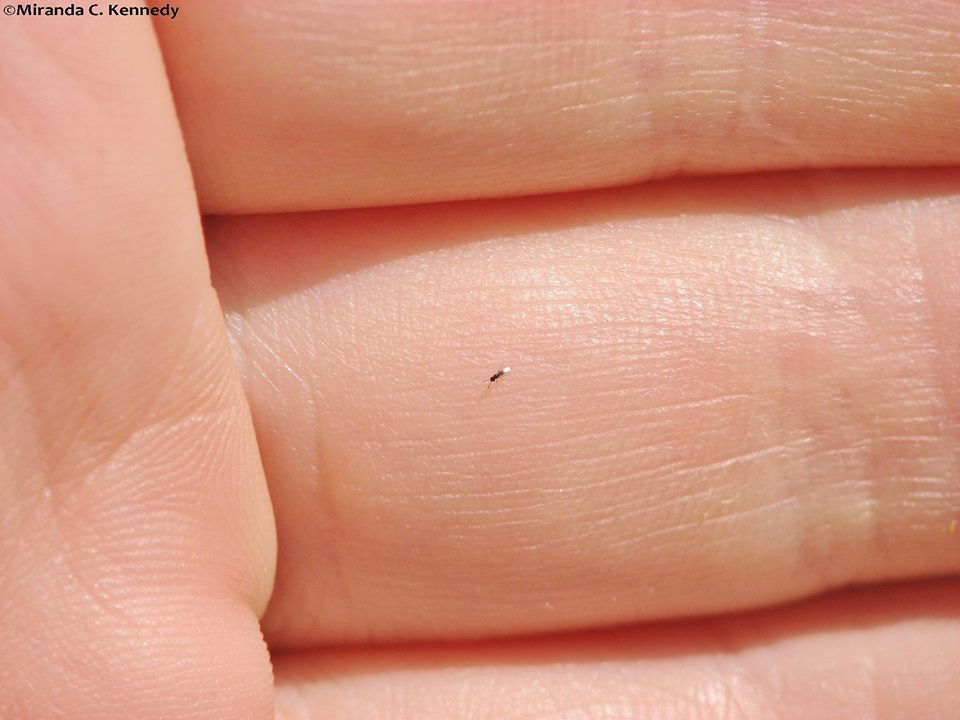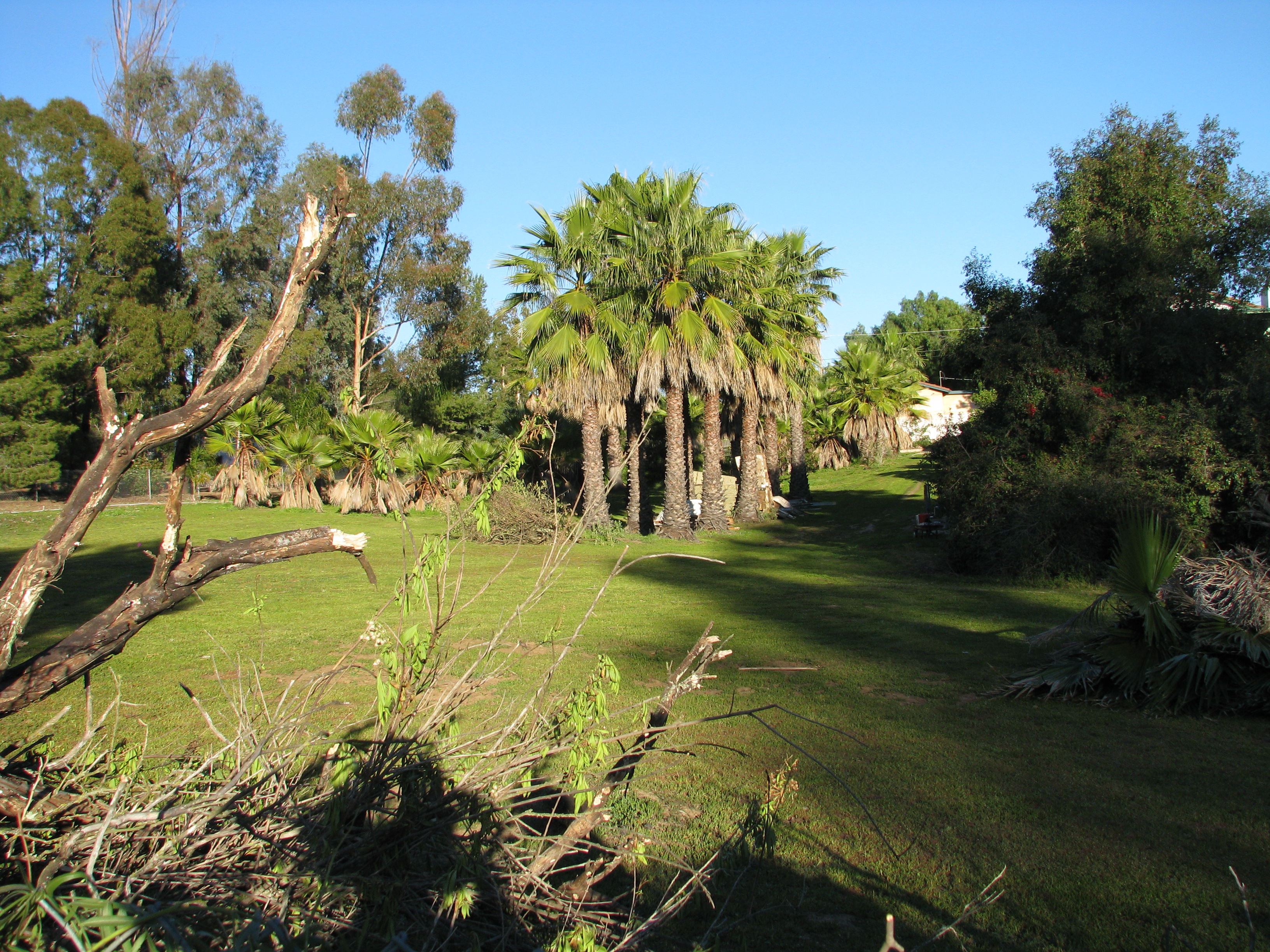Natives
- Animals, Bees, Birding, Gardening adventures, Natives, Other Insects, Permaculture and Edible Forest Gardening Adventures, Ponds, Rain Catching, Soil
Summer At Finch Frolic Garden
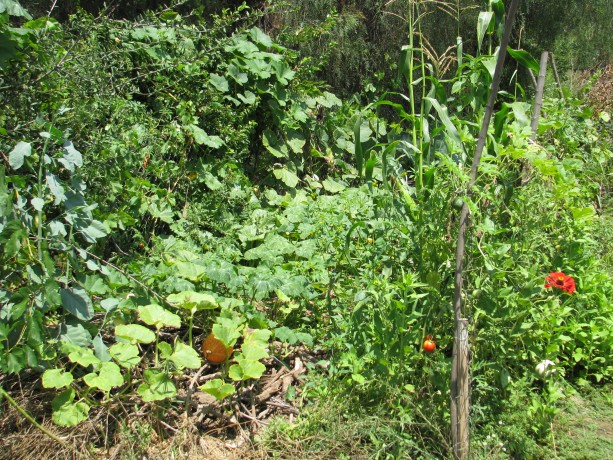
Squash, melons, tomatoes, flowers, tomatillos, sweet potatoes and more flourish along a chain link fence and on a wire-and-post trellis we set up over buried wood. Vertical space is perfect for vines; the vines provide shade and protection for other plants, and mulch plus a harvest when they die down. They are exciting and fun to watch grow as well. I’ve wanted to show you more of the garden, using video as well as photos. The summer garden is beautiful and full of life. Life in the ground, in the water, in the air and on every plant. Last year the pond had an overgrowth of pond weed and algae. Since our pond is natural – meaning that it has no liner, just compressed clay, and is cleaned only by plants and fish with no other aeration or filtration – the idea of adding algaecide is unthinkable. In great pond water there are as many if not more microbes as in good soil. Algaecide may advertise that it doesn’t harm fish or frogs, but it will kill the small pond life that is keeping your pond and its animals healthy. Seven small koi were added (rescued from a golf course pond where they had been dumped) in the hopes that they would eat the emergent pond weed as it grew out of dormancy. We hadn’t seen the koi and thought that they were dead. A couple of months ago they were sighted: all seven, each about a foot long and magnificent. We have no pond weed nor algae overgrowth thanks to these beauties.
In the following short video you’ll see some of the koi and possibly some of the bluegill and mosquito fish that also inhabit the pond. Notice a small blue dragonfly alighting on the bamboo pole. Birds call out all around. You’ll also hear my work shoes squeaking! The size and vigor of the water lilies is due to the healthy, microbially balanced water. We keep the pond topped up from the well. Well water here in San Diego County is notoriously salty and mineral-laden. Plants and microbes remediate that water, as is obvious in this video. The last part is of the native marsh fleabane which was sown by wild birds and flourishes around the pond. The small groups of flowers are perfect for our tiny native insects to land upon and feed. A honeybee uses it here. Enjoy with me a moment by the pond; the following link will send you to a Youtube video:
- Animals, Bees, Birding, Building and Landscaping, Chickens, Cob, Compost, Composting toilet, Fungus and Mushrooms, Gardening adventures, Giving, Health, Heirloom Plants, Hiking, Houses, Hugelkultur, Humor, Living structures, Natives, Natural cleaners, Other Insects, Permaculture and Edible Forest Gardening Adventures, Pets, Photos, Predators, Quail, Rain Catching, Recycling and Repurposing, Reptiles and Amphibians, Seeds, Soil, Vegetables, Water Saving, Worms
Special Tours for Aug. and Sept., 2014
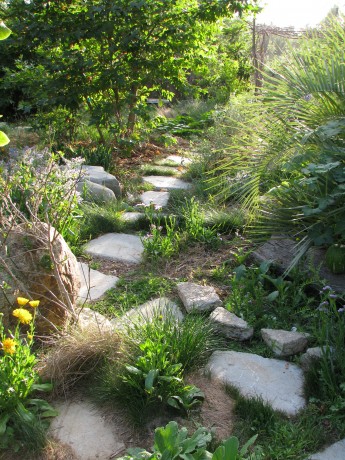
Come take a tour of a food forest! Normally tours of Finch Frolic Garden are held by appointment for groups of 5 – 15 people, Thursdays – Mondays. Cost is $10 per person and the tour lasts about two hours. By popular demand, for those who don’t have a group of five or more, we will be hosting Open Tour days for the first 15 people to sign up in August and September. They will be Sunday, August 10 and 24, Sept. 7 and 21, and Thursdays August 7 and 28, and Sept. 11 and 25. Tours begin promptly at 10 am. The tours last about two hours and are classes on basic permaculture while we tour the food forest. I ask $10 per person. Please reserve and receive directions through dianeckennedy@prodigy.net. Children under 10 are free; please, no pets. Photos but no video are allowed. Thank you for coming to visit! Diane and Miranda
- Animals, Bees, Birding, Books, Building and Landscaping, Chickens, Cob, Compost, Composting toilet, Fungus and Mushrooms, Gardening adventures, Heirloom Plants, Hugelkultur, Humor, Living structures, Natives, Natural cleaners, Other Insects, Permaculture and Edible Forest Gardening Adventures, Ponds, Predators, Quail, Rain Catching, Recycling and Repurposing, Reptiles and Amphibians, Seeds, Soil, Water Saving, Worms
Permaculture Lectures At Finch Frolic Garden, June 2014

Tour Finch Frolic Garden! Permaculture Lectures in the Garden!
Learn how to work with nature and save money too
Finch Frolic Garden and Hatch Aquatics will present four fantastic, information-filled lectures in June. Join us at beautiful Finch Frolic Garden in Fallbrook, 4 pm to 6 pm, for refreshments and talks on…
Saturday, June 7: Introduction to Permaculture and Finch Frolic Tour: We’ll take you through the main precepts of permaculture and how it can be applied not only to your garden, but to yourself and your community. Then we’ll tour Finch Frolic Garden and show rain catchments, swales, plant guilds, polyculture, living buildings and so much more.
Saturday, June 14: Your Workers in the Soil and Earthworks: Learn the best methods for storing water in the soil and how to replace all your chemicals with actively aerated compost tea and compost.
Saturday, June 21: Aquaculture: You can have a natural pond – even in a tub! How natural ponds work, which plants clean water and which are good to eat. Even if you don’t want a pond, you’ll learn exciting information about bioremediation and riparian habitat.
Saturday, June 28: Wildlife in your Garden: What are all those bugs and critters and what they are doing in your yard? We’ll discuss how to live with wildlife and the best ways to attract beneficial species.
Your hosts and lecturers will be
Jacob Hatch Owner of Hatch Aquatics. With years of installing and maintaining natural ponds and waterways, and a Permaculture Design Course graduate, Jacob has installed earthworks with some of the biggest names in permaculture.
Miranda Kennedy OSU graduate of Wildlife Conservation and wildlife consultant, Miranda photographs and identifies flora and fauna and maps their roles in backyard ecosystems.
Diane Kennedy Owner of Finch Frolic Garden, lecturer, consultant, Permaculture Design Course graduate, former SDC Senior Park Ranger, Diane educates homeowners on how to save money and the environment while building their dream gardens.
Each class limit is 50 attendees, so please make pre-paid reservations soon before they fill up. Fee for set of four lectures and tour is $45 per person. Single session fee is $20 per person. Contact Diane Kennedy at dianeckennedy@prodigy.net for reservations and directions.
You will not want to miss this fascinating and useful information!
- Building and Landscaping, Compost, Fungus and Mushrooms, Gardening adventures, Heirloom Plants, Hugelkultur, Natives, Permaculture and Edible Forest Gardening Adventures, Rain Catching, Seeds, Soil, Water Saving
The Albedo Effect: How Bare Earth Causes Wild Weather
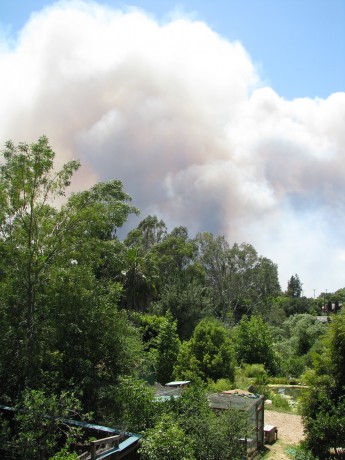
This week’s 100F+ temperatures and high Santa Ana winds have fueled three fires close to us. It is May, not October. Albedo is a reflection coefficient. In layman’s terms it is the effect that happens when sunlight is reflected off of white areas. There is the high albedo of bare earth, snow and ice, and clouds, and the low albedo of water and vegetation. There is less reflection from dark areas such as off of water and green areas, and darker areas, just like dark clothing, absorbs more heat rather than reflects it like white clothing does. There are arguments that we should cut down all the trees to increase white space to stop global warming. NO! The plant life that occupies the green spaces transpire water and excess heat into the air, causing cloud cover. Clouds, of course, insulate the earth from the sun and their albedo effect is cooling to the earth, not to mention that clouds amass moisture and – bingo – you get rain. It is the loss of green areas and the desertification of large masses of Africa, and the in-progress desertification of the already drier areas of the world (such as California) that makes the albedo effect one that is helping warm our climate. Great tracks of land now reflect light into cloudless skies; water sources dry up and plants die so transpiration disappears. The loss of air-borne water (evapotranspiration) allows areas around the desert area to also dry out. The rapid change of climate due to desertification, loss of topsoil and the resulting erosion and the melting of our ice caps (creating larger oceans and thus larger thermal masses to reflect heat) causes severe weather patterns – weather patterns that balance out huge dry desert areas with destructive rain and wind storms in other areas. Drying areas ignite… here in San Diego North County there are five fires burning as I sit, and heavy smoke and ash rain down on everything between them. My house is not threatened at this time, but we may be evacuated. So many people are evacuated right now and the highways are packed. There is another fire near San Diego, and two between here and Los Angeles. It is May – usually we have these temperatures, wild winds from the desert called Santa Ana winds, and fire threat in October. Our lack of rain doesn’t bode well for California.
My point is that to help balance nature out again, we need to hurriedly lessen the amount of reflected light in areas where we were traditionally covered by plants. We need to plant. We need to plant native plants. We need to re-green our landscapes, in each backyard and vacant lot, as quickly as we can. Allow the plants to keep moisture in the soil, to slow flooding, to transpire moisture into our atmosphere so that rain comes back to the desert areas. We need to hold what rain that falls in our soil by burying wood (hugelkultur), by creating level swales and mulching, mulching, mulching. Yet on trash day I see bags and bags of leaves set on the street ready to go to the dump. We need to stop erosion areas by using whatever means we can to keep the topsoil back. We need native trees with long roots that will hold the soil, build topsoil and transpirate.
Of course you probably can’t afford lots of plants, so plant natives that will quickly grow large. Between the slower-growing oaks, plant sages, mallows, ceanothus, quail bush and other bushes that cover 10 -15 feet of dry earth. Under them will be moisture, protected soil with mulch from their leaves, and habitat for lizards, frogs, small birds and hundreds of insects. These bushes will help shade young oaks, sycamores, and other trees and keep their trunks from scorching.
Throw down seeds of California fescue (Festuca californica var. parishii) to hold soil and cover the dry, reflective areas. This native grass is tough and doesn’t cause trouble like non-native grasses. You can seed it with California poppies, lupine and other native flowers. Aggressively weed out non-native species.
Since I was little, in the 60’s, I heard the mantra ‘plant a tree’. Obviously we haven’t been doing that. I think it should be changed to ‘plant a tree and don’t cut down any more because the earth can’t afford it’!
Please plant! And all my hope goes to you and yours who are threatened or have had losses from our severe weather.
- Animals, Bees, Birding, Chickens, Cob, Compost, Composting toilet, Fungus and Mushrooms, Gardening adventures, Health, Heirloom Plants, Hiking, Humor, Living structures, Natives, Natural cleaners, Other Insects, Permaculture and Edible Forest Gardening Adventures, Pets, Photos, Ponds, Predators, Quail, Rain Catching, Reptiles and Amphibians, Seeds, Soil, Water Saving, Worms
Finch Frolic Facebook!
Thanks to my daughter Miranda, our permaculture food forest habitat Finch Frolic Garden has a Facebook page. Miranda steadily feeds information onto the site, mostly about the creatures she’s discovering that have recently been attracted to our property. Lizards, chickens, web spinners and much more. If you are a Facebook aficionado, consider giving us a visit and ‘liking’ our page. Thanks!
- Animals, Bees, Birding, Compost, Fruit, Fungus and Mushrooms, Gardening adventures, Herbs, Hugelkultur, Natives, Other Insects, Permaculture and Edible Forest Gardening Adventures, Ponds, Predators, Rain Catching, Reptiles and Amphibians, Seeds, Soil, Vegetables, Water Saving, Worms
The Mulberry Guild
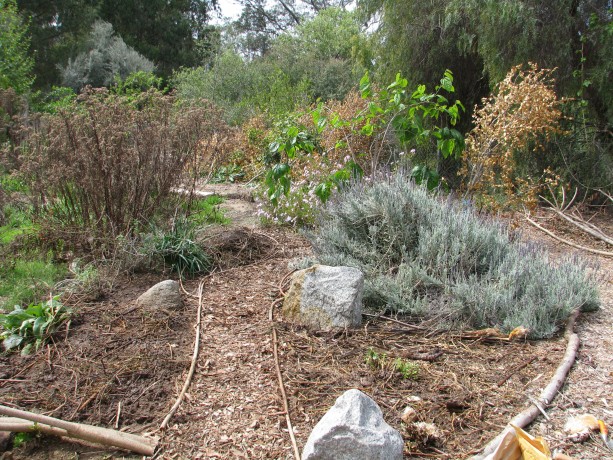
The renovated and planted mulberry guild. One of our larger guilds has a Pakistani mulberry tree that I’d planted last spring, and around it had grown tomatoes, melons, eggplant, herbs, Swiss chard, artichokes and garlic chives.

Mulberry guild with last year’s plant matter and unreachable beds. This guild was too large; any vegetable bed should be able to be reached from a pathway without having to step into the bed. Stepping on your garden soil crushes fungus and microbes, and compacts (deoxygenates) the soil. So of course when I told my daughter last week that we had to plant that guild that day, what I ended up meaning was, we were going to do a lot of digging in the heat and maybe plant the next day. Most of my projects are like this.
Lavender, valerian, lemon balm, horehound, comfrey and clumping garlic chives were still thriving in the bed. Marsh fleabane, a native, had seeded itself all around the bed and had not only protected veggies from last summer’s extreme heat, but provided trellises for the current tomatoes.
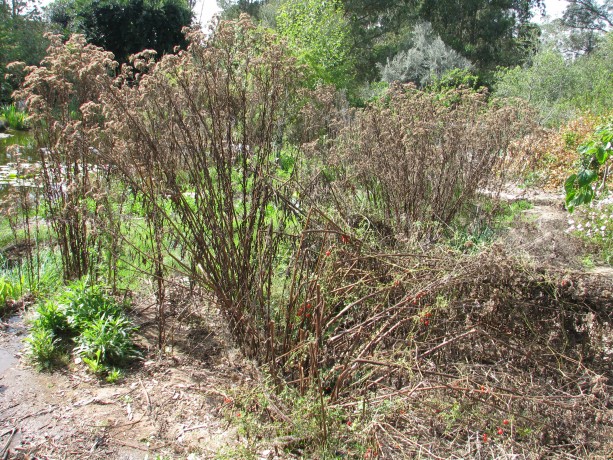
Fleabane stalks from last year, with new growth coming from the roots. Marsh fleabane is an incredible lure for hundreds of our tiny native pollinators and other beneficial insects. Lots of lacewing eggs were on it, too. The plants were coming up from the base, so we cut and dropped these dead plants to mulch the guild.
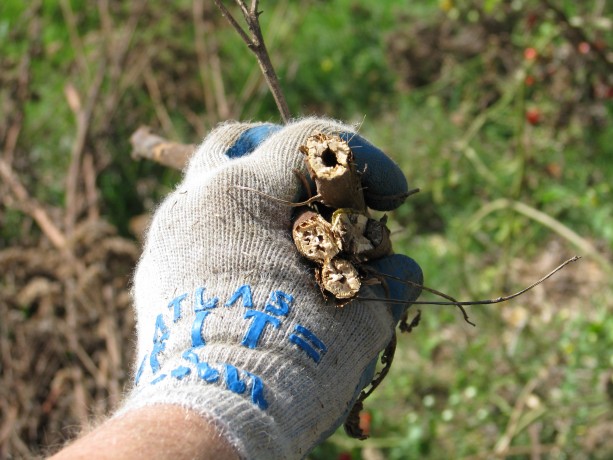
The stalks of fleabane are hollow… perfect homes for small bees! The stems were hollow and just the right size to house beneficial bees such as mason bees. This plant is certainly a boon for our first line of defense, our native insects.
We also chopped and dropped the tomato vines. Tomatoes like growing in the same place every year. With excellent soil biology – something we are still working on achieving with compost and compost teas – you don’t have to rotate any crops.

Slashed and dropped tomato and fleabane. We had also discovered in the last flood that extra water through this heavy clay area would flow down the pathway to the pond, often channeled there via gopher tunnels.
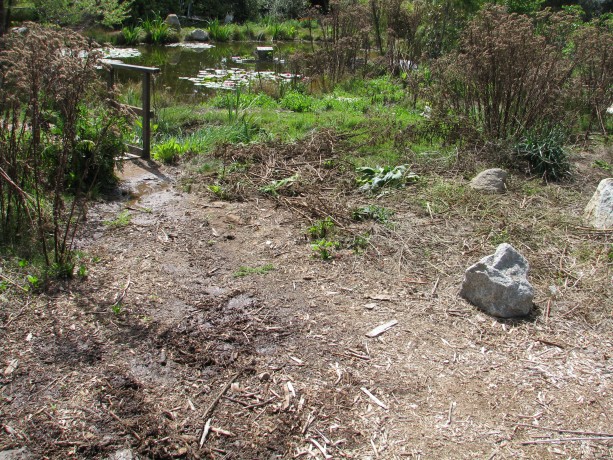
The pathway is a water channel during heavy rains. It needs fixing. We decided to harvest that water and add water harvesting pathways to the garden at the same time. We dug a swale across the pathway, perpendicular to the flow of water, and continued the swale into the garden to a small hugel bed.

Swale dug on contour through the pathway and across the guild. Hugelkultur means soil on wood, and is an excellent way to store water in the ground, add nutrients, be rid of extra woody material and sequester carbon in the soil. We wanted the bottom of the swale to be level so that water caught on the pathway would slowly travel into the bed and passively be absorbed into the surrounding soil. We used our wonderful bunyip (water level).
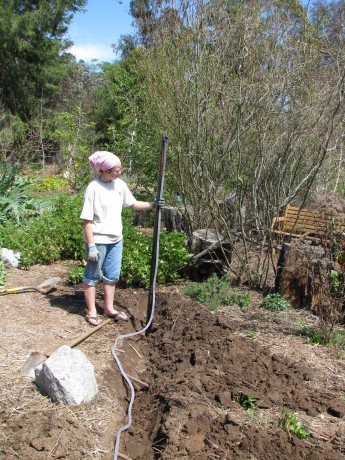
Using a bunyip to make the bottom of the swale level. Water running into the path will now be channeled through the guild. Because of the heavy clay involved we decided to fill the swale with woody material, making it a long hugel bed. Water will enter the swale in the pathway, and will still channel water but will also percolate down to prevent overflow. We needed to capture a lot of water, but didn’t want a deep swale across our pathway. By making it a hugel bed with a slight concave surface it will capture water and percolate down quickly, running along the even bottom of the swale into the garden bed, without there being a trippable hole for visitors to have to navigate. So we filled the swale with stuff. Large wood is best for hugels because they hold more water and take more time to decompose, but we have little of that here. We had some very old firewood that had been sitting on soil. The life underneath wood is wonderful; isn’t this proof of how compost works?

The activity under an old log shows so many visible decomposers, and there are thousands that we don’t see. We laid the wood into the trench.
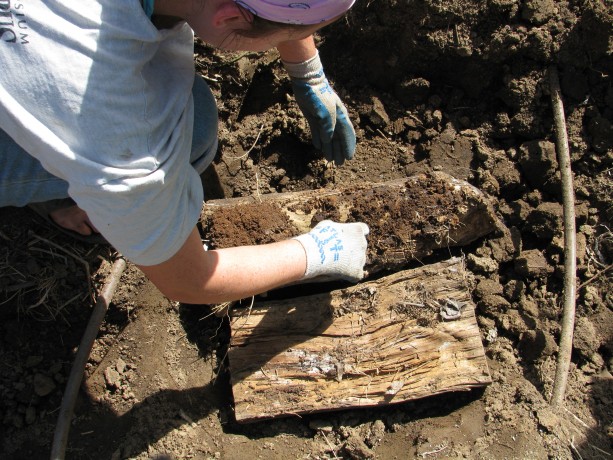
Placing old logs in the swale. If you don’t have old logs, what do you use? Everything else!
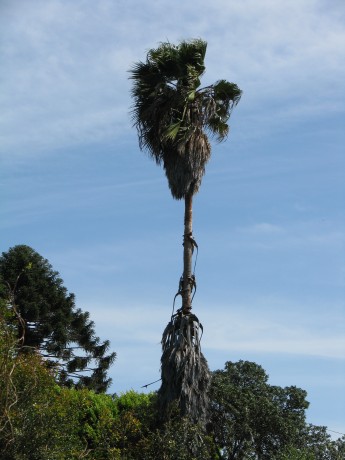
This giant palm has been a home to raccoons and orioles, and a perch for countless other birds. The last big wind storm distributed the fronds everywhere. We are wealthy in palm fronds.
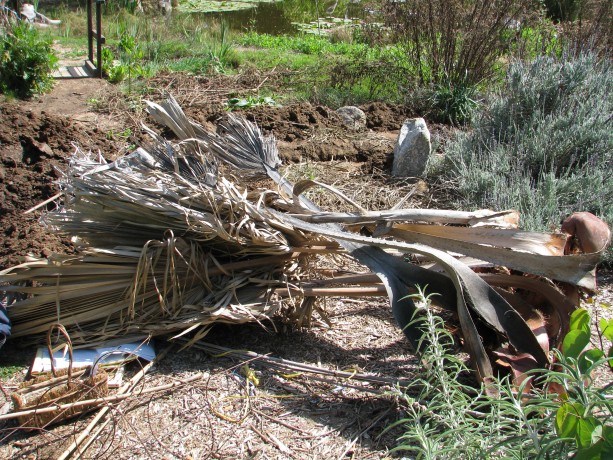
Three quick cuts (to fit the bed) made these thorny fronds perfect hugelbed components. We layered all sorts of cuttings with the clay soil, and watered it in, making sure the water flowed across the level swale.
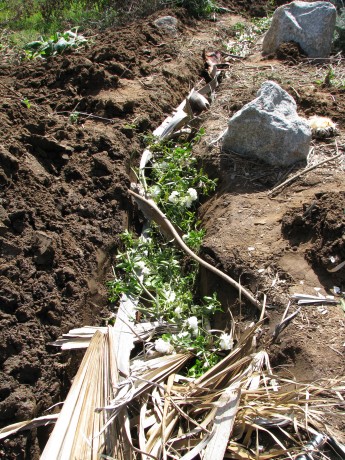
We filled the swale with fronds, rose and sage trimmings, some old firewood and sticks, and clay. As we worked, we felt as if we were being watched.
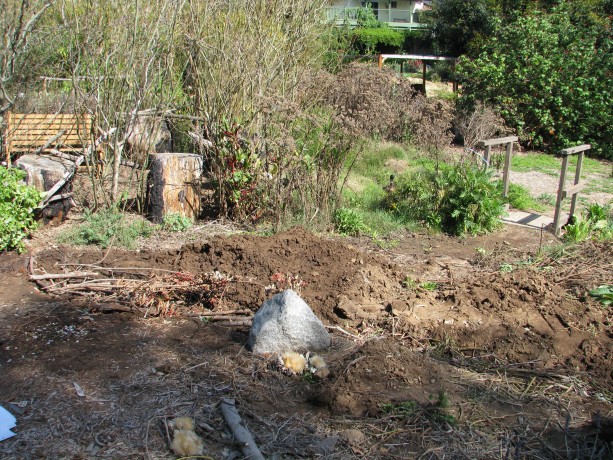
Can you spot the duck in this photo? Mr. and Mrs. Mallard were out for a graze, boldly checking out our progress. He is guarding her as she hikes around the property, leading him on a merry chase every afternoon. You can see Mr. Mallard to the left of the little bridge.

This male mallard and his mate, who is ‘ducked’ down in front of him, enjoyed grazing on weeds and watching we silly humans work so hard. After filling the swale, we covered the new trail that now transects the guild with cardboard to repress weeds.
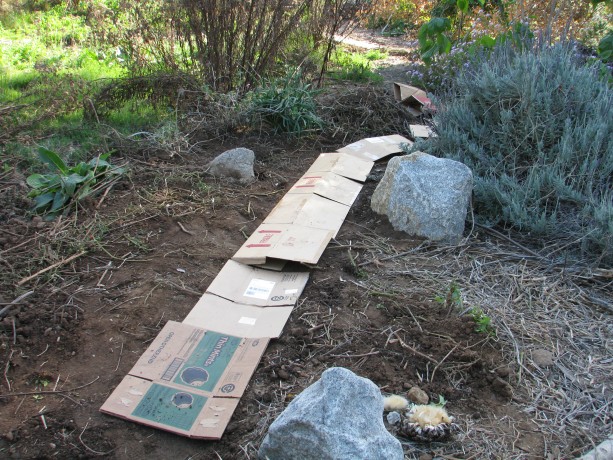
Cardboard laid over the hugelswale. Then we covered that with wood chips and delineated the pathway with sticks; visitors never seem to see the pathways and are always stepping into the guilds. Grrr!

The cardboard was covered with wood chips and the pathway delineated with sticks. Where the trail curves to the left is a small raised hugelbed to help hold back water. At this point the day – and we – were done, but a couple of days later we planted. Polyculture is the best answer to pest problems and more nutritional food. We chose different mixes of seeds for each of the quadrants, based on situation, neighbor plants, companion planting and shade. We kept in mind the ‘recipe’ for plant guilds, choosing a nitrogen-fixer, a deep tap-rooted plant, a shade plant, an insect attractor, and a trellis plant. So, for one quarter we mixed together seeds of carrot, radish, corn, a bush squash, leaf parsley and a wildflower. Another had eggplant, a short-vined melon (we’ll be building trellises for most of our larger vining plants), basil, Swiss chard, garlic, poppies, and fava beans. In the raised hugelbed I planted peas, carrots, and flower seeds.
In the back quadrant next to the mulberry I wanted to trellis tomatoes.
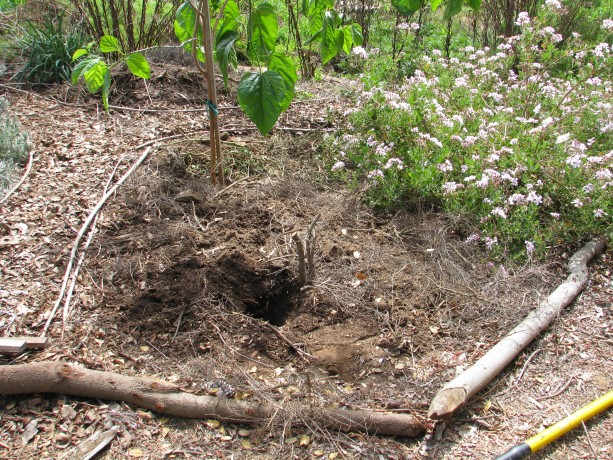
This quadrant by the mulberry needed a trellis for tomatoes. I’d coppiced some young volunteer oaks, using the trunks for mushroom inoculation, and kept the tops because they branched out and I thought maybe they’d come in handy. Sure enough, we decided to try one for a tomato trellis. Tomatoes love to vine up other plants. Some of ours made it about ten feet in the air, which made them hard to pick but gave us a lesson in vines and were amusing to regard. So we dug a hole and stuck in one of these cuttings, then hammered in stakes on either side and tied the whole thing up.
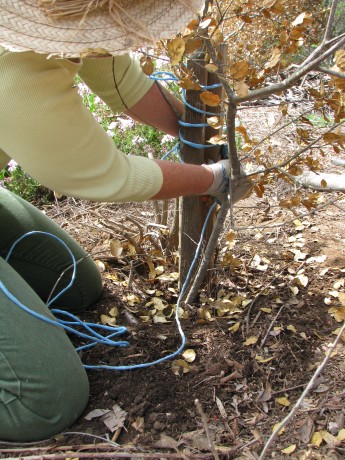
Tying the trunk to two stakes with twine taken from straw bales. Love the blue color! The result looks like a dead tree. However, the leaves will drop, providing good mulch, the tiny current tomatoes which we seeded around the trunk will enjoy the support of all the small twigs and branches, and will cascade down from the arched side.

The ‘dead tree’ look won’t last long as the tomatoes climb over it and dangle close to the path for easy harvesting. We seeded the area with another kind of carrots (carrots love tomatoes!) and basil, and planted Tall Telephone beans around the mulberry trunk to use and protect it with vines. We watered it all in with well water, and can’t wait to see what pops up! We have so many new varieties from Baker Creek Heirloom Seeds and other sources that we’re planting this year! Today we move onto the next bed.
- Animals, Gardening adventures, Hugelkultur, Natives, Other Insects, Permaculture and Edible Forest Gardening Adventures, Ponds
Then and Now
This photo was taken just as work was begun on transforming the property into a garden, in February, 2011.
This photo was taken last Thursday, Oct. 31, 2013, from the same location.
This view may look weedy, especially in the early morning light on this brilliant Halloween morning. What you are seeing is the first bog, which is the green spot in the foreground. The dirt area is the overflow, if torrential rains ever come again. To the left, the tall bushes constitute the withy hide, and to the left is the big pond, although you have to take my word for it. Tall bamboo arches over the stumps of the palm trees in the above photo, which are trellises for roses and other vines. A nectarine branch is in the right foreground. The tall flowering plants are a native called fleabane. They reseed readily, and I allow them to because of several reasons. They grow five to six feet tall and help shade smaller trees and plants against the harsh summer sun, protecting them from sun scald. They also die off in the winter, making good hugelkultur material. The purple flowers, which are in the above photo now turning into fuzzy seed clumps, are attractive. The most important thing though is that they are excellent hosts for native insects of all kinds. Ladybugs, lacewings, spiders, and hundreds of tiny wasps and flies, many of which are parasitic, all love these flowers. All summer long they are alive with life. Inviting in the native pollinators, and growing a polyculture garden, is the first line of defense in growing naturally.
Allowing nature to define parts of your garden leads to happy surprises and lots of help from unexpected friends, such as bugs, birds and lizards. This kind of garden is endlessly interesting, with new things to study every day.
The following photos were all taken the same brilliant morning, Oct. 31, 2013. Here in San Diego county we were having what is called a Santa Ana, where warm, dry winds from the desert blow westward, as opposed to the more humid eastward flow of air from the ocean that we normally have. Santa Anas can bring heavy winds and make tinder-dry weedy hills a fire hazard, but this year we’ve been lucky and no major fires have happened. We even had almost 3/4 ” of rain, last week, which is practically unheard of for October. The warm Autumn sunshine was intense and lovely, and I had to take photos even though the light was too strong for good ones.
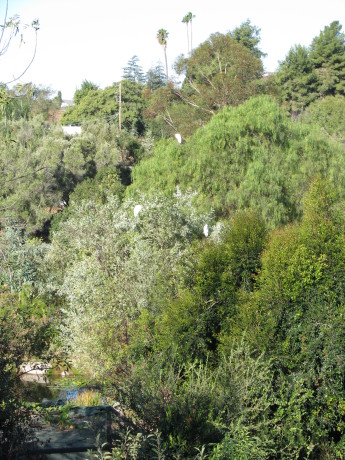
We went up on the roof to view these three greater egrets perched in our trees over the pond. 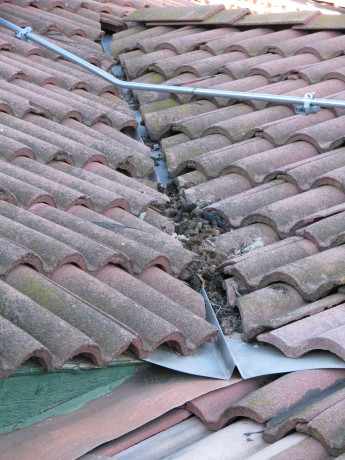
Being on the roof is an education. Here is lots of racoon poo between the tiles. Why?! 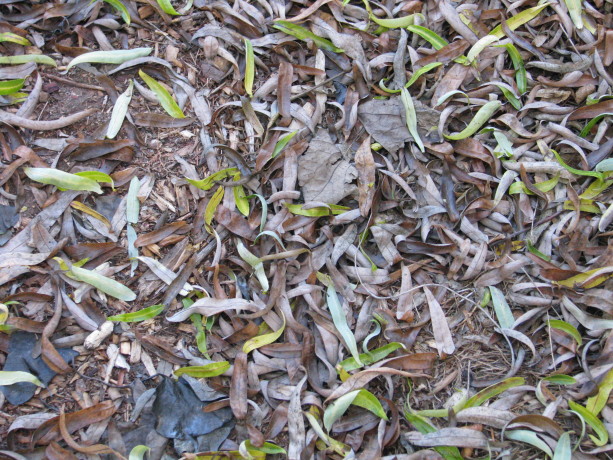
We don’t have dramatic Fall colors here, but the subtle Autumn hues of leaves is lovely. 
We still have Monarch butterflies. 
The big pond in early morning light. 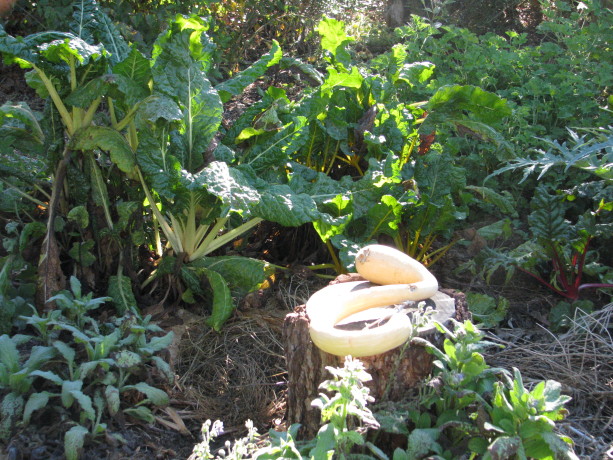
A zuchianno rampicante reclining on a stump. (Its a squash!). 
Morning sun through a Fall-leaved sycamore. Beautiful. 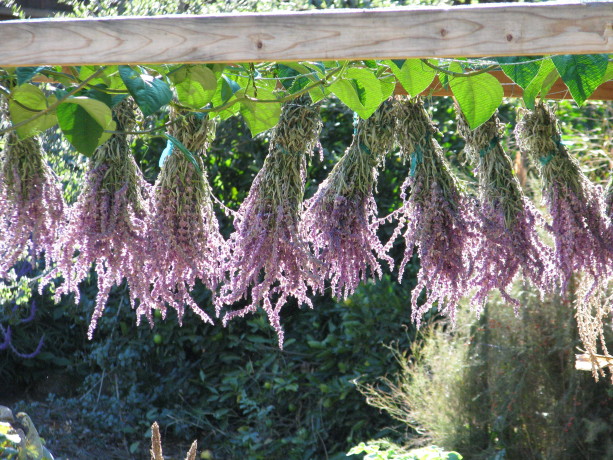
Mexican bush sage hanging up to dry. 
Our little pecan tree put on about six this year! Next year, tons! 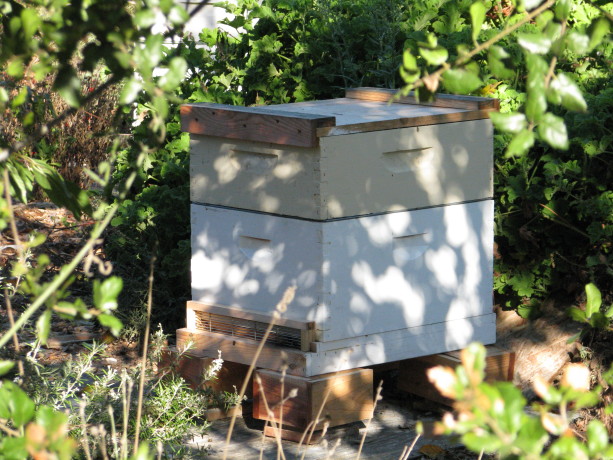
Beehive warming up. 
Ceder waxwings (my favorite bird) in the big palm. 
The Bee Garden. 
The liquidambers, also known as sweet gums, are just beginning to turn color. Lots of deciduous trees means lots of leaf mulch, and more warmth reaching the ground during the winter. 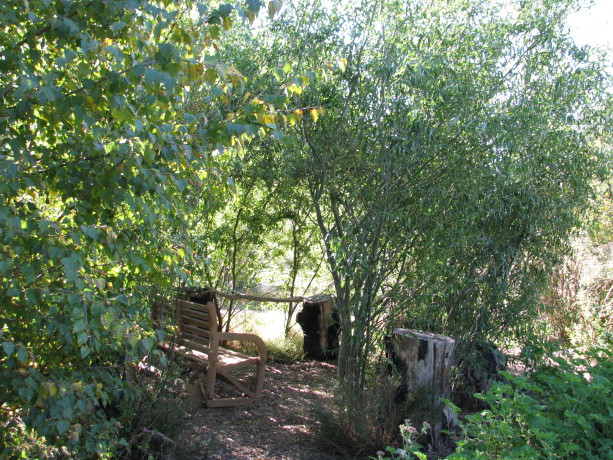
The entrance to the withy hide, with the pond in the distance. 
The Mission fig,with artichoke, anise and sage.. 
The canopy is growing. 
Greater egret enjoying the sun. - Animals, Chickens, Cob, Compost, Composting toilet, Fruit, Gardening adventures, Giving, Grains, Health, Herbs, Houses, Hugelkultur, Humor, Living structures, Natives, Natural cleaners, Permaculture and Edible Forest Gardening Adventures, Ponds, Rain Catching, Recipes, Seeds, Soil, Vegan, Vegetables, Vegetarian, Worms
San Diego Permaculture Convergence, Nov. 9 – 10, 2013
There is a fantastic, information-packed permaculture convergence coming up at the beautiful Sky Mountain Institute in Escondido.
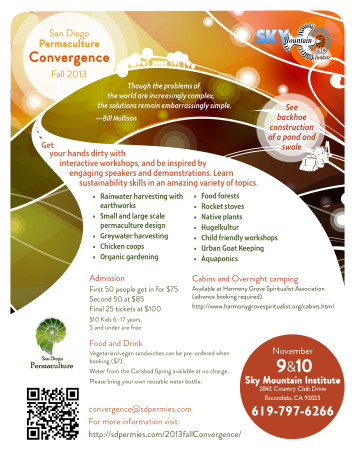 It will be two days packed with great information for a very reasonable price; in fact, scholarships are available. Check out the website at convergence@sdpermies.com. On that Sunday I’ll be teaching a workshop about why its so important to plant native plants, how to plant them in guilds using fishscale swales and mini-hugelkulturs. Come to the convergence and be inspired!
It will be two days packed with great information for a very reasonable price; in fact, scholarships are available. Check out the website at convergence@sdpermies.com. On that Sunday I’ll be teaching a workshop about why its so important to plant native plants, how to plant them in guilds using fishscale swales and mini-hugelkulturs. Come to the convergence and be inspired! -
Tiny Hugels and Fishscale Swales: Small water catchment
In permaculture it is recommended to design long level, contoured swales throughout your property to catch rainwater. Long swales, however, won’t work when the property is small, or if it is already mostly planted, or if the hiring of large equipment or teams of diggers isn’t feasable, or if long swales aren’t part of a lovely garden. What then?
In the gardens for which I’ve written consultations I’ve recommended what Geoff Lawton (of the Permaculture Design Institute of Australia) calls fishscale swales. Small curved swales staggered up a slope so that rainwater can be caught and held. One overflows into another, just like a pinball machine.
Any swale, no matter how small, will help hold water. I put them in just above each plant, the width of the dripline of the plant. I also combine them with burying wood (hugelkultur). I don’t have a lot of branches or logs, but I do have a lot of extra pieces of lumber salvaged when the sheds were dismantled. These pieces are untreated (no paint or pressure treatment), and if they have nails and screws in them, even better! The hardware will mineraize the soil as it decomposes. This wood is already very old and dry, and thus will soak up water a treat. If you soak the wood in water, compost tea or a microbial brew before you bury it, that’s super. If not, don’t worry about it. The idea is that rainwater will accumulate in the swale, percolate into the soil and into the wood below it. There the wood will hold water as it breaks down, gradually irrigating and fertilizing the plant below.
Wood can be placed on top of the soil and buried as the swale is dug, or it can be dug into the ground and covered. The swale is filled with mulch o help retard weed growth; if by a walkway the scale filled with mulch then it may be walked on without fear of a twisted ankle.
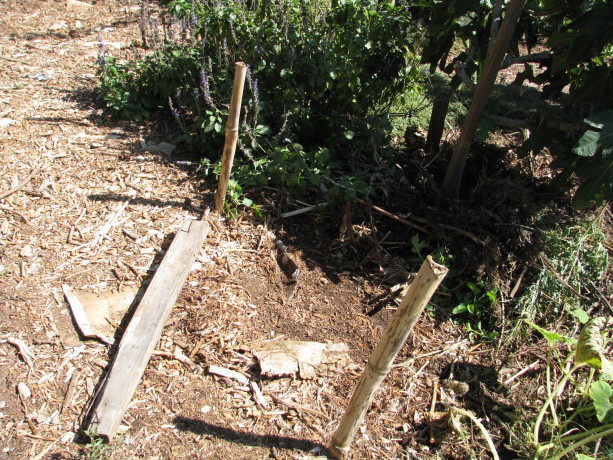
This area right above the fig is small, but large enough to catch water. Here I have a Mission fig that has been slow to grow due to irregular watering (NOT my fault!)
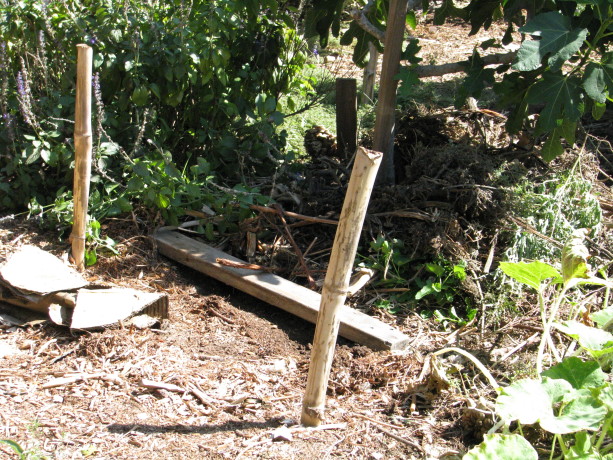
I laid out a board right on the ground. Figs like a little water and this area has been on the dry side. In the direction from which rainwater would flow, above the tree, I laid out a few pieces of old lumber, nails and all.
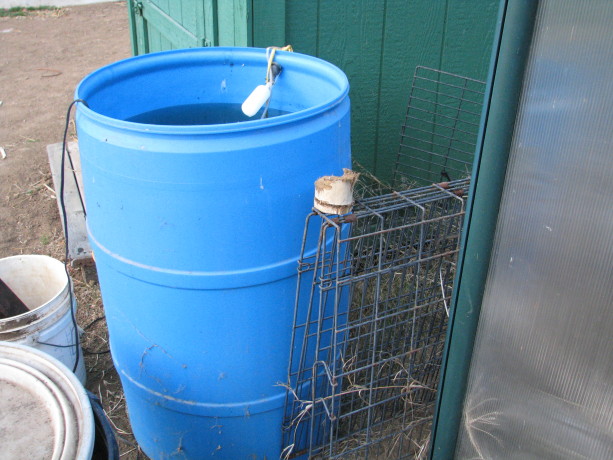
Brewing microbial tea. I happened to be brewing a large batch of microbial tea, so I threw the wood into a bucket of the stuff and let it absorb some.

I soaked the wood in microbial tea for a few minutes. They happen to be the width of the existing dripline of the tree; again, any swale and and wood will help. I dug a small swale the same length, a shovel’s width wide, and threw the dirt on top of the wood.
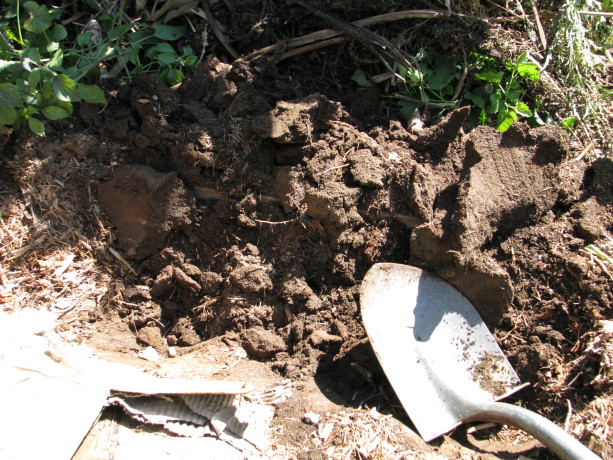
I dug a swale, using the dirt to cover the board. Then I filled the swale with mulch and voila! the job is done. This will now catch rainwater, hold moisture, and fertilize the tree, as well as finding something useful for junk lumber. Burying the wood sequesters the gasses released in decomposing materials into the soil rather than the air thus helping reduce greenhouse gasses.

I filled the swale with mulch to keep down weeds. Presto! Done! Using fishscale swales and mini-hugelkultur beds when planting most native plants can really help them become established in a low-water situation. This wild rose (rosa rugusa) is being planted in a very dry area, and I wanted to bury the wood below soil level to keep it closer to the roots of the plant. I dug a small trench and laid out some boards, nails down.
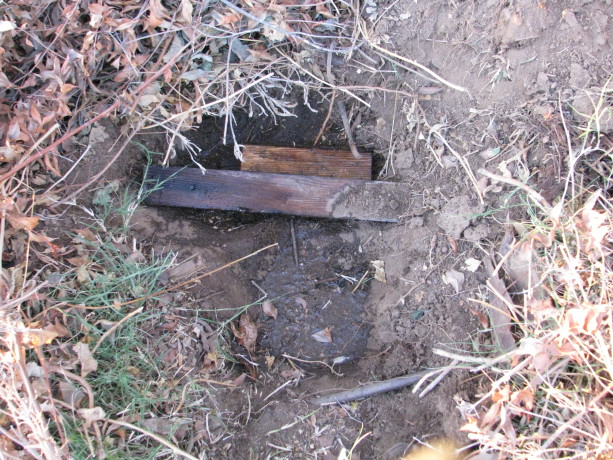
I dug a little ways into the dirt and laid out the soaked wood. Then as I dug the swale I layered the wood with dirt and a couple more boards until buried. I filled in the swale with mulch and planted the rose on the downhill side.

Here you’ll see the rootball of the new wild rose in front of the wood. I threw in some coyote scat since it was lying there so conveniently. There’s quite a microbial boost for the rose!

Some coyote scat went in, too. Sorry! Remember that here in a dry climate we need to plant so that the root ball is even with the ground, or make the whole catch basin a little lower. Otherwise the roots will dry out. Planting so that the root ball is a little above the ground is a common practice is rainy areas.
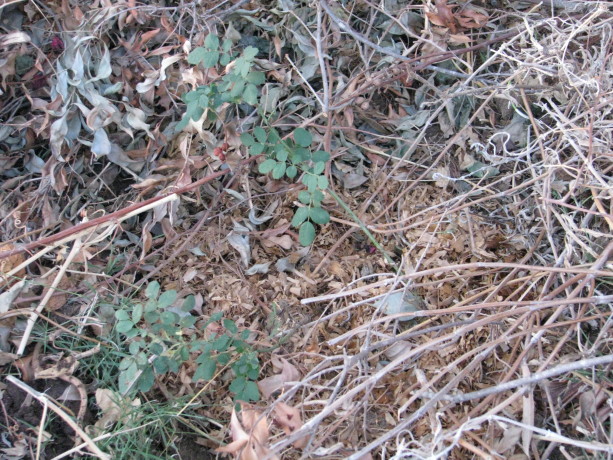
Here is the planted rose, with mulch pulled up around it. Remember native plants have communities. Certain plants grow with certain others because they are mutually beneficial. This rose was planted within the dripline of an Engelmann oak, one place it is found.

Many native trees like the company of other natives. I planted this rose just outside the dripline of this oak, one of the places it would naturally grow in the wild. So swales don’t have to be gigantic earthworks projects. They can be small and alternated down a slope, or just individual ones above new or existing plants. Throw some wood into a mini-hugel between the swale and the plant and you’ll water less, fertilize naturally, and compost leftover wood. Don’t forget cotton clothing and bedding… that all works, too!
.
- Gardening adventures, Heirloom Plants, Natives, Permaculture and Edible Forest Gardening Adventures, Soil, Vegetables
Valentine’s in the Garden
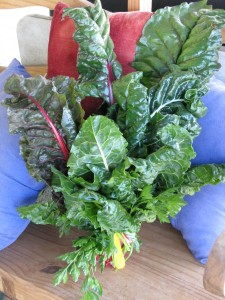
A rainbow chard and parsley bouquet for Valentine’s Day Another gorgeous day in the garden today. I gave a chard bouquet to my friend Lara who has been so kind as to teach me piano over the last two months (I’ve progressed from the ‘clink clink’ stage to the two-handed ‘clink-clink-CLINK’ stage. Lara deserves chard!). My best Valentine’s was receiving my box of organic seeds from Botanical Interests. Yep, ordered too many again. At least it won’t make me fat.

Great seeds! Can’t wait to plant! It was warm enough for shorts, and since my neighbors can’t see me, I indulged for awhile.
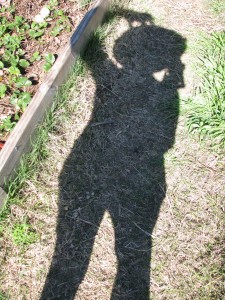
Shorts on Valentine’s Day! (No I’m not THAT short, and go figure what my hand is doing to my hat!) At the end of December I had planted two flats of seeds and stuck them in the greenhouse; one had winter veggies and the other native plants.
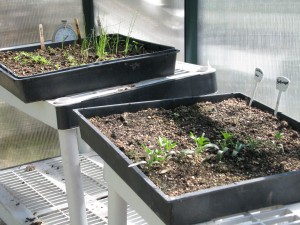
Bladderpod and leeks. A couple of weeks ago I was telling my daughter in college that only one of each had come up so far. She pointed out that the two were curiously linked: bladderpod and leeks! It seems even my garden is a comedian. Today I transplanted the bladderpod into larger containers.

Transplanted bladderpods. Bladderpod (Isomeris arborea) is a true California native living at home in the desert or at the coast and usually in the worst soils. It flowers most of the year even in drought conditions, providing nectar for pollinators and hummingbirds. The plant doesn’t smell so great, but it has wonderful balloon-like pods that rattle when dry. It is a fantastic addition to gardens.
In planting seeds in flats it always looks as if roots are shallow until you take the plant up and find a healthy and sometimes long root system. Don’t let the top growth make you think that the roots aren’t developed.
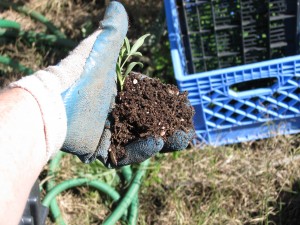
The root ball of this little bladderpod seedling is healthy and full. No more natives are showing their faces in the flat yet, but they have their own schedule and I’ll continue to watch the flat for signs. Just as animals (including humans) respond to circadian rhythms with the 24/hour sleep/wake cycle, plant growth is cued in not only by warmth, but by length of daylight hours. For plants it is called photoperiodicity. You can casually throw that into a conversation over the dinner table tonight and see if anyone notices. A plant’s response to daylight length is called photoperiodic. There is much more to this, and you can read up on it here. So to make a short story longer, I don’t manipulate the light in the greenhouse so I wait longer time than recommended for seeds to sprout just in case they really don’t want to get out of bed yet. I can empathize.
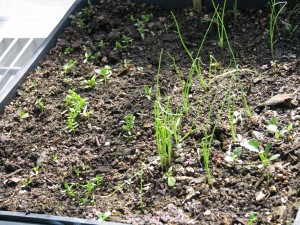
Little celery and parsnip sprouts and leggy leeks that need transplanting, In the veggie flat celery and parsnips have decided to sprout so I’ll transplant them out in a week or two.
Elsewhere in the garden the nitrogen-fixers are working away.

Pea ready to grab onto a bamboo support pole. Fava beans have sprouted from leftover seed from last year and they are already in bloom.
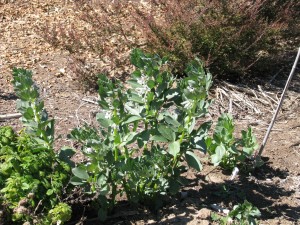
Bees love the blooming favas. The weather is so beautiful that I want to plant the summer veggies… I’m yearning for tomatoes! I will be good and wait a few more weeks until all chance of frost is gone (hopefully the weather won’t be too crazy and frost in March!). Then, look out! Seeds everywhere! And yes, by popular demand I will write about trashcan potatoes.
